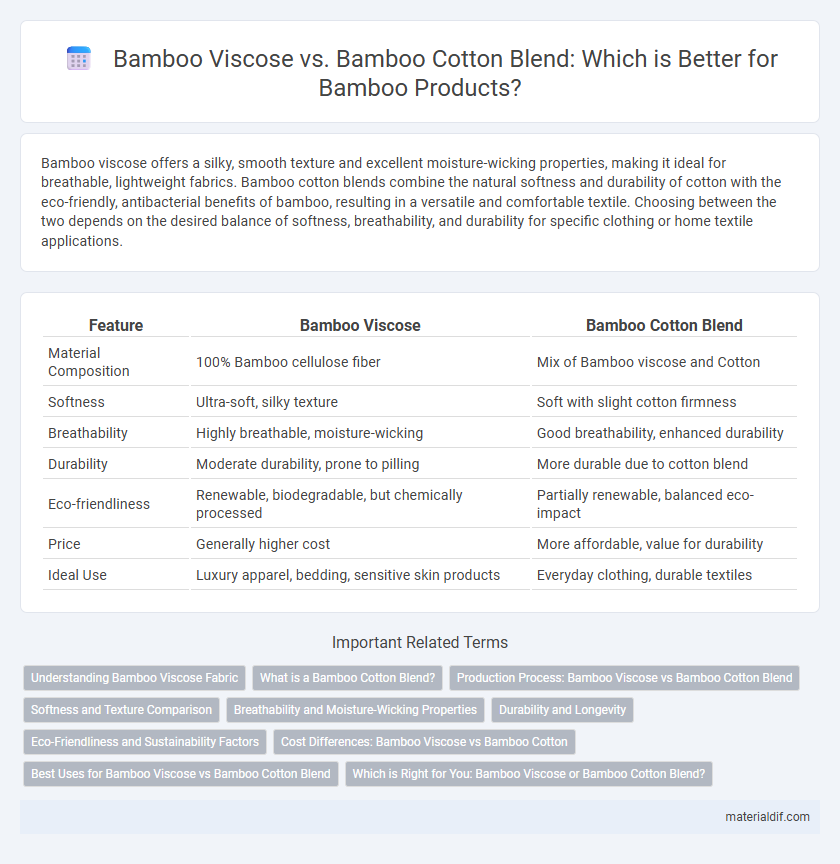Bamboo viscose offers a silky, smooth texture and excellent moisture-wicking properties, making it ideal for breathable, lightweight fabrics. Bamboo cotton blends combine the natural softness and durability of cotton with the eco-friendly, antibacterial benefits of bamboo, resulting in a versatile and comfortable textile. Choosing between the two depends on the desired balance of softness, breathability, and durability for specific clothing or home textile applications.
Table of Comparison
| Feature | Bamboo Viscose | Bamboo Cotton Blend |
|---|---|---|
| Material Composition | 100% Bamboo cellulose fiber | Mix of Bamboo viscose and Cotton |
| Softness | Ultra-soft, silky texture | Soft with slight cotton firmness |
| Breathability | Highly breathable, moisture-wicking | Good breathability, enhanced durability |
| Durability | Moderate durability, prone to pilling | More durable due to cotton blend |
| Eco-friendliness | Renewable, biodegradable, but chemically processed | Partially renewable, balanced eco-impact |
| Price | Generally higher cost | More affordable, value for durability |
| Ideal Use | Luxury apparel, bedding, sensitive skin products | Everyday clothing, durable textiles |
Understanding Bamboo Viscose Fabric
Bamboo viscose fabric is derived from bamboo cellulose processed through a chemical pulping method to create a soft, breathable, and moisture-wicking material ideal for textiles. Unlike bamboo cotton blends, which mix bamboo fibers with cotton for added durability and texture, bamboo viscose offers superior smoothness and a silk-like feel while maintaining eco-friendly properties. Understanding the production process and fabric characteristics is essential to choosing bamboo viscose for sustainable clothing that maximizes comfort and breathability.
What is a Bamboo Cotton Blend?
A bamboo cotton blend combines the natural softness and moisture-wicking properties of bamboo viscose with the durability and breathability of cotton fibers. This fabric blend offers enhanced comfort, improved strength, and better temperature regulation compared to pure bamboo viscose or cotton alone. Popular in sustainable fashion, bamboo cotton blends provide eco-friendly advantages while maintaining easy care and long-lasting wear.
Production Process: Bamboo Viscose vs Bamboo Cotton Blend
Bamboo viscose is produced through a chemical-intensive process where bamboo fibers are dissolved using solvents and then regenerated into viscose fibers, resulting in a soft and silky fabric. In contrast, a bamboo cotton blend combines natural bamboo fibers with cotton fibers, typically processed mechanically with less chemical intervention, preserving more of the natural fiber qualities. The production of bamboo viscose involves industrial treatments that can impact environmental sustainability, whereas bamboo cotton blends often offer a balance between eco-friendliness and fabric durability.
Softness and Texture Comparison
Bamboo viscose offers a silky, smooth texture with exceptional softness due to its fiber processing method, making it ideal for delicate skin. Bamboo cotton blends combine the breathable, natural feel of cotton with the luxurious softness of bamboo viscose, resulting in a slightly coarser but more durable fabric. The blend provides a balanced texture that retains softness while enhancing fabric strength and moisture-wicking properties.
Breathability and Moisture-Wicking Properties
Bamboo viscose showcases superior breathability due to its streamlined fiber processing, allowing enhanced airflow and temperature regulation compared to bamboo cotton blends. The moisture-wicking properties of bamboo viscose effectively draw sweat away from the skin, promoting quicker evaporation and dryness, whereas bamboo cotton blends retain more moisture, reducing comfort during intense activity. Manufacturers often prefer bamboo viscose for activewear and performance fabrics because of these optimized breathability and moisture management benefits.
Durability and Longevity
Bamboo viscose offers a silky softness but tends to have lower durability compared to bamboo cotton blends, which combine the strength of cotton fibers with bamboo's natural properties for enhanced longevity. The bamboo cotton blend fabric withstands repeated washing and wear more effectively, making it ideal for everyday clothing and textiles requiring resilience. Choosing bamboo cotton blends ensures greater fabric longevity while maintaining eco-friendly benefits associated with bamboo.
Eco-Friendliness and Sustainability Factors
Bamboo viscose is created through a chemical-intensive process that reduces its eco-friendliness despite bamboo's natural sustainability, whereas bamboo cotton blends combine bamboo fibers with cotton, altering the fabric's environmental impact based on cotton cultivation practices. Bamboo viscose production often involves hazardous chemicals like sodium hydroxide and carbon disulfide, raising concerns about pollution and energy consumption. Bamboo cotton blends can offer a more sustainable choice when incorporating organic cotton, as organic farming reduces pesticide use and water consumption compared to conventional cotton.
Cost Differences: Bamboo Viscose vs Bamboo Cotton
Bamboo viscose generally costs more than bamboo cotton blends due to the intensive chemical processing required to convert bamboo pulp into viscose fiber. Bamboo cotton blends reduce overall material costs by combining natural cotton fibers with bamboo, offering a more affordable option without sacrificing breathability or softness. Price variations also reflect production scale and fiber quality, with bamboo viscose often positioned as a premium textile in eco-friendly markets.
Best Uses for Bamboo Viscose vs Bamboo Cotton Blend
Bamboo viscose excels in soft, breathable fabrics ideal for activewear, underwear, and lightweight summer clothing due to its moisture-wicking and antibacterial properties. Bamboo cotton blends offer enhanced durability and structure, making them suitable for everyday apparel, bed linens, and casual wear that benefits from the combined strength and comfort of both fibers. Choosing between bamboo viscose and bamboo cotton blends depends on the desired balance of softness, breathability, and fabric resilience for specific applications.
Which is Right for You: Bamboo Viscose or Bamboo Cotton Blend?
Bamboo viscose offers exceptional softness, moisture-wicking properties, and a silky texture, making it ideal for sensitive skin and breathable clothing. Bamboo cotton blends combine bamboo's natural antibacterial qualities with cotton's durability and firmness, providing a balanced fabric fit for everyday wear and easy maintenance. Choosing between bamboo viscose and a bamboo cotton blend depends on your preference for luxury softness versus long-lasting strength and versatility.
Bamboo viscose vs bamboo cotton blend Infographic

 materialdif.com
materialdif.com